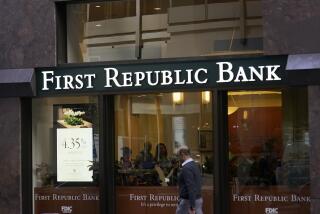800 S&Ls; Likely to Flunk Tough New Rules, U.S. Says : Will Need $20 Billion to Stay Open
WASHINGTON — Federal officials said today that 800 savings and loan associations are likely to fail tough new capital standards being imposed next month and will have to raise as much as $20 billion to keep operating.
The new rules, required by the S&L; bailout law, call for all thrifts to hold capital equal to 3% of their assets. Institutions that fall short will face strict government supervision while they are trying to meet the standards.
“These new standards will require savings institutions to become stronger and will thereby reduce the exposure of the federal deposit insurance fund to losses,” M. Danny Wall, director of the Office of Thrift Supervision, said of the standards, designed to reduce further failures of savings and loan institutions.
The office, created by the savings and loan bailout law passed by Congress last summer, estimated that 800 thrift institutions with assets totaling $600 billion would not be able to meet the capital requirements immediately.
Those failing to comply will have immediate growth restrictions imposed on them by the office and will be required to develop capital restoration plans detailing the steps they will take to meet the new standards.
The announcement was made as James Barth, the office’s chief economist, told an S&L; industry group in Chicago that thrift institutions lost at least $2.5 billion in the July-September quarter, probably the best performance in a year.
Anticipating the new standards, many thrifts have been selling assets and reducing their size recently, and the thrift office said many of them will be able to meet the new requirements by the time they take effect on Dec. 7.
A key provision in the reform bill requires S&L; owners to risk more of their own capital as a buffer between losses and government deposit insurance funds.
The standards require S&Ls; to keep in reserve at least 1.5% tangible capital and 3% core capital and meet a risk-based capital requirement.
Tangible capital consists of common stock plus retained earnings but excludes most intangible assets, such as good will.
Core capital consists of tangible capital plus good will. Good will is an accounting term referring to the amount above actual cash value paid by an investor for a troubled thrift.
Risk-based capital consists of 8% of the value of risk-weighted assets when the new rule is fully phased in.
“The minimum capital for the credit risk component--the risk of a loan not being repaid--is calculated by multiplying the value of each asset (including off-balance-sheet commitments) by one of five risk factors and holding 8% of the result as the minimum required capital,” the office said.
It said the five risk categories range from 0% for cash to 200% for certain delinquent loans and repossessed property.
For example, it said, a typical home mortgage has a risk factor of 50%. Thus, the risk capital required capital on a $100,000 home mortgage loan would be $4,000.
The risk-based capital requirement was described as the “most important” of the three standards that will make S&L; standards “no less stringent” than those imposed on the commercial banking industry.
More to Read
Inside the business of entertainment
The Wide Shot brings you news, analysis and insights on everything from streaming wars to production — and what it all means for the future.
You may occasionally receive promotional content from the Los Angeles Times.










